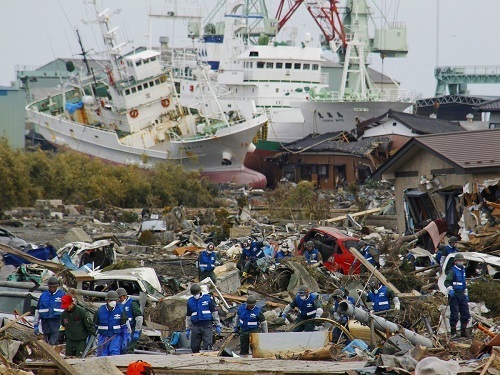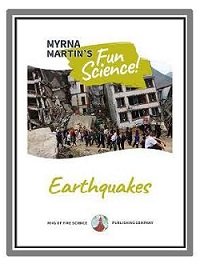fascinating Earthquake Facts
Searching for answers
New earthquake facts are still being discovered
New
earthquake facts are being discovered by scientists constantly. Our family
lives on the Pacific Ring of Fire in the Cascadia Subduction Zone. People in
our area are being warned that we are overdue for a major earthquake. The
plates are locked and the tension in the rocks is increasing.

2011 Japan earthquake and tsunami destruction
People
often wonder what causes earthquakes
Converging tectonic plates
Plates moving on the surface of the Earth converge in areas all
over our planet. If two continental plates converge the result are towering
mountain ranges like the Himalayan Mountains. The collision of the Indian Plate
and the Eurasian plate smashing together has created the Himalayan Mountains and the Tibetan
Plateau.
body waves
P waves and S waves are body waves
Earthquake facts on seismograms led to the discovery that all earthquakes produce P waves and S waves. Small and large earthquakes
produce seismic waves when rocks break apart. P waves and S waves are called
body waves because they travel through the interior (body) of the Earth. Scientists
studying earthquake waves inside the earth have discovered three major
boundaries.

Our Earthquake book is packed with fascinating earthquake facts plus an activity in each chapter. Chapter topics in the book include Earthquake History, San Andreas Fault, Moment Magnitude Scale and Preparing for Natural Hazards. Myrna Martin

Click for More Information and to Order
Boundaries inside the Earth
Moho boundary
Andrija Mohorovicic looking for earthquake facts about the
inside of the Earth discovered a boundary that varied depending whether it was below
continental plates or oceanic plates. He had discovered the boundary between
the crust and the mantle. The boundary was named the Mohorovicic discontinuity often
shortened to Moho.
Earth's core
Beno Gutenberg looking for earthquake facts about the Earth
below the Moho boundary discovered that S waves stopped at a secondary boundary
inside the Earth. He knew these two earthquake facts. S waves only travel through
solids and P waves travel through solids, liquids and gases. Gutenberg then
knew that inside the Earth was a liquid core that stopped the S waves.
Solid inner core
Inge Lehmann, a Danish seismologist, discovered the solid
inner core using the speed and path of P waves that originated in New Zealand. She
discovered that P waves slowed down in the liquid outer core and then sped up
for a short time. She realized from these earthquake facts that the Earth has a
solid inner core inside the liquid outer core.
Earthquake Zones
Plate movement creates earthquakes
Scientists looking for earthquake facts about plate movement
used the information gathered from seismographs all over the Earth. They
discovered that most earthquakes are produced by plate movement. They used seismograms
that are the written records produced by a seismographs to plot the exact
location of earthquakes.
Scientists then discovered earthquake facts they gathered from the seismographs created earthquake zones. These zones of earthquakes showed the boundaries of the crustal plates that are moving on the surface of the Earth.
More Links to Earthquake Facts
Largest Earthquake of the 20th Century
Faults move up, down and sideways
Focus & Epicenter of an Earthquake
2010 Haiti & Dominican Earthquake .
P Waves Travel Inside the Earth
Mercalli Scale Measures Intensity
What are Megathrust Earthquakes?
KIDS FUN Science Bookstore
Check out Myrna Martin's award winning textbooks, e-books, videos and rock sets. The Kids Fun Science Bookstore covers a wide range of earth science topics. Click here to browse.










